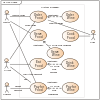Node (UML)
Appearance
The topic of this article may not meet Wikipedia's general notability guideline. (October 2015) |
This article needs additional citations for verification. (February 2009) |

A node[1] in the Unified Modeling Language (UML) is a computational resource upon which UML artifacts may be deployed for execution.[1]
There are two types of nodes: device nodes and execution environments.
- A device represents hardware devices: a physical computational resource with processing capability upon which UML artifacts may be deployed for execution. Devices may be complex (i.e., they may consist of other devices).[2]
- An execution environment represents software containers (such as operating systems, JVM, servlet/EJB containers, application servers, portal servers, etc.) This is a node that offers an execution environment for specific types of components that are deployed on it in the form of deployable artifacts.[2]
Execution environments can be nested. Nodes can be interconnected through communication paths to define network structures. A communication path is an "association between two DeploymentTargets, through which they are able to exchange signals and messages".[2]
Usage
[edit]When modeling devices, it is possible to model them in several different ways:
- Name a device using the type and make, for instance "IBM RS6000", "HP 9000".
- Name a device using its intended function, for instance "Database Server", "High Speed Switch"
- Name a device using the operating system deployed on it, for instance "Linux Server", "Solaris Server".
Use tagged values to specify characteristics of devices / execution environments, for instance "Memory=2GB", "Disk Space=32GB", "Version=2.5.1".
References
[edit]- ^ a b "Nodes". Unified Modeling Language 2.5.1. OMG Document Number formal/2017-12-05. Object Management Group Standards Development Organization (OMG SDO). December 2017. p. 387, 396, 403, 657.
- ^ a b c OMG (2008). OMG Unified Modeling Language (OMG UML), Superstructure, V2.1.2 Archived 2010-09-23 at the Wayback Machine p.199-210.

